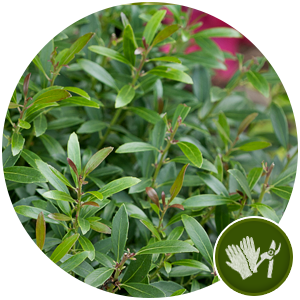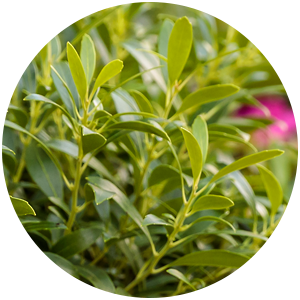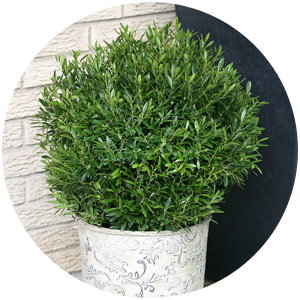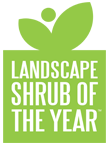GEM BOX®
ILEX GLABRA
An Easy Native Alternative to Boxwood
- Low-maintenance evergreen with native roots
- Naturally maintains a dense, ball-shaped form
- Responds well to shearing, if desired
- Small, dark green leaves shine in every season
- Tiny white spring flowers attract pollinators
- Thrives in sun and part sun
- 2-3’ tall x 2-3’ spread
- Hardy in USDA Zones 5-9
If you love the look of boxwood hedges but need something easier to maintain, or prefer shrubs with native roots, Gem Box inkberry holly is a perfect choice. At first glance, it’s tough to tell the two evergreens apart—both have tiny, dark green leaves and a rounded shape. Where Gem Box pulls ahead is in its strong disease resistance and naturally neat habit that doesn’t require shearing to keep its shape. Is it time for you to make the switch?
how to grow gem box® ilex

Planting
Though it looks different than what you might traditionally think of as holly, Gem Box truly is a holly. As such, it shares a love of moist, acidic soil.
Gem Box holly will thrive in any amount of sunlight except deep shade, so choose a spot that sees at least four hours of direct sun per day. Think about where you could use an evergreen hedge to define a border, line a pathway, or fill in under the windows at your home’s foundation. How would a pair of Gem Box hollies in large containers look flanking your front entry?
When planting, dig the hole about twice as wide but just as deep as the container it is growing in. If the roots are densely circled around when you take the plant out of the pot, loosen them up a bit to break the “root memory”. This will encourage them to grow outward instead of continuing to grow in a circular pattern.
Set the plant in the hole, making sure that the top of the rootball is level with the top of the surrounding soil. Then backfill the hole with the soil you dug out. Press it down with your hand firmly to eliminate any big air pockets around the roots.
Lastly, water the plant again to help the soil settle. Spread some mulch around the base of the plant, taking care to keep it from touching the plant’s stems. The mulch will help to retain soil moisture and protect the roots during winter.

Growing Tips
Broad-leaf evergreen shrubs like Gem Box holly flush out in spring with a set of beautiful, soft new foliage that covers the entire plant. As the new growth matures, it darkens in color and the stems stiffen. The best time to prune is soon after that new spring growth has finished emerging. When you shear it that time of year, it will remain that size for most of the rest of the season.
When another flush of new growth occurs in fall and the weather is still relatively warm, don’t be tempted to prune your holly again. If you do, it will stimulate more soft new growth which will likely be killed back in winter. If you must prune your hollies in fall, do so once the weather has cooled down significantly and the plant is no longer actively growing.
Gem Box holly will naturally keep its dense, ball-shaped form without pruning. That said, we know some people love to prune their shrubs! If that sounds like you, a pair of electric hedge trimmers is the easiest tool for the job. Go ahead and shear it into a smaller ball, box or tuna can. The tighter the shape, the more formal the look. If formality isn’t your thing, skip the pruning.

Uses
Gem Box holly is ideal for anyone who wishes to grow low-maintenance evergreen shrubs in sun or partly sunny spaces. If you are planting a new garden or renovating the one you have, consider this beautiful, easy plant.
Think about how you or your neighbors use boxwood in the garden. Gem Box is a disease resistant, native alternative that can give you the same look and be used in all the same ways—hedges, foundations, borders, containers and more. Shear it into shape or enjoy its naturally rounded form.
Standing just 2-3’ tall, Gem Box holly fits neatly under window ledges without blocking the view. Its smaller size also makes it easy to grow in large containers. Just keep in mind that this zone 5 hardy shrub is easiest to overwinter in containers in zones 7-9.
Double hedges are popular in many parts of the country. That’s when a taller evergreen hedge, like those made of North Pole® arborvitae, is layered behind a shorter hedge of boxwood, yews or inkberry holly like Gem Box. Double hedges make outstanding formal foundation or property line plantings. By using Gem Box, you’ll cut down on the necessary shearing time tremendously.
top 3 reasons to grow
gem box® ilex
THIS DEPENDABLE EVERGREEN SHINES ALL YEAR
Gem Box is a disease resistant, evergreen holly that maintains its classy good looks year-round.
NO SHEARING NEEDED
While some types of evergreen shrubs require annual pruning, Gem Box naturally maintains its densely rounded shape.
IT FEELS GOOD TO PLANT NATIVES
Gem Box’s native roots help it to be durable and dependable in the landscape, so you can enjoy it for decades to come.
video: using gem box® ilex in a classic spring arrangement
Gem Box® Ilex glabra ‘SMNIGAB17’ USPP27554 Can5629
